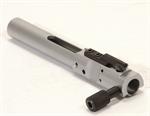American Spirit Arms. The bolt handle doesn't have to reciprocate. In combat weapons, having something outside the weapon moving means it could catch or impact on a support or rest, causing a stoppage.
Each type of bolt handle has it's good points and bad points, on a recreational shooter, it's a serious upcharge to get a different kind - $150 to $300. Weigh carefully exactly what it does better and if it's even needed. On a long range shooter in competition, a right side bolt handle offers charging with the trigger hand because the off hand is trapped by the shooting jacket and sling. On a combat gun, it's not a high priority, as you don't charge it all that often, and rarely in combat. It's designed to avoid it.
The bolt handle on a self loading weapon is only used to charge it once - the initial loading and chambering being done "inside the wire," if not already in that condition. Combat zones mean weapons are kept loaded at hand, not empty locked in a rack.
From there, the weapon cycles and loads itself. When out of ammo, the bolt is held back, mag inserted, bolt release tripped, the bolt chambers a round, and firing can immediately resume. The charging handle may not be used at all until there is no ammo to be had.
What some people are making of it is when the weapon needs a chamber check, or a malfunction has occurred. Shoot full power ammo, maintain the weapon, it's the magazines or ammo that cause most of the problems, and the charging handle the best solution. That's a very rare situation in combat. Since the soldier is trained to shoot from cover, he can likely take a moment to figure it out. What interferes is a huge adrenaline dump and a lack of experience.
That translates to a highly marketable improvement at a good markup from cost - where you see a lot of the buzz about it. The better answer is what DOD has done to change it - nothing. It's been like that for over 45 years.


